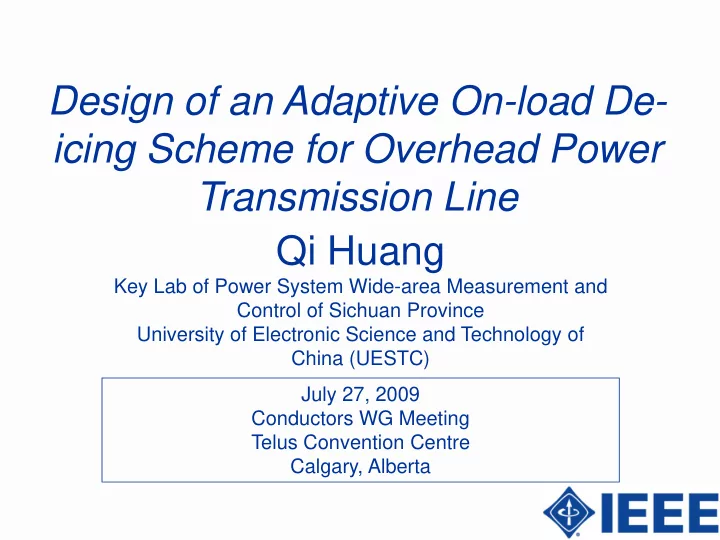

Design of an Adaptive On-load De- icing Scheme for Overhead Power Transmission Line Qi Huang Key Lab of Power System Wide-area Measurement and Control of Sichuan Province University of Electronic Science and Technology of China (UESTC) July 27, 2009 Conductors WG Meeting Telus Convention Centre Calgary, Alberta
Contents of the presentation � Introduction of UESTC � Presentation of the paper � Introduction � System Architecture � Modeling and Reflection Coefficient � Numerical Simulation � Designed System � Initial Results � Conclusion and Future Work
UESTC � Renowned as China’s cradle for the national electronic industry, UESTC is one of the best Universities in Electronic and Information Technology in China � Among the universities first selected into Project 211 (1997) and Project 985 (2001) � Located at Chengdu, “the land of abundance ”, the hometown of panda
UESTC � Key Lab of Power System Wide-area Measurement and Control of Sichuan Province, founded in 2008, is supported collaboratively by UESTC and Sichuan Electric Power Corporation, which is responsible for the operation and control of Sichuan Power Grid, a typical sending end power grid. (Major participator in “Project for Delivering Electricity from the West to the East ”)
UESTC Power Transfer: 120 GW Beijin g Shang Sichuan Hai & Chongqin g Guang zhou
Presentation of the paper
Introduction � The atmospheric ice accumulation on high voltage transmission lines is one of the most serious problems in cold regions � Any single or multiple transmission line outages can significantly alter the transmission system operating configuration such that continuity between energy delivery sources to system load points (Typically involves large geographical area) is interrupted.
Introduction Most area of China is affected by macro climate, micro climate and microtopography, becoming one of areas that is most severely affected by ice
Introduction 2008 ice storm in South China more than 8500 towers collapse, more than 35,000 electrical lines down and 2007 substations were affected Affected 500kV Tower in Sichuan Power Grid Courtesy of Sichuan Electric Power Corporation
Introduction � Currently available de-icing solution can be categorized into thermal and mechanical � Thermal: change the operation of the power � short-circuit de-icing system, even interrupting the service � current channeling through power flow circulation � electro-impulse de-icing (EIDI) method not efficient, may cause damage to � HVDC the transmission hardware or � Mechanical: loosening of the structure � electromagnetic forces � De-icing trolley
De-icing with high frequency high voltage excitation � long range of action: the effective distance can be up to 100 km. � can be used for on-load de-icing: no transfer or interruption of loads during de-icing � highly efficient due to the joint effect of dielectric loss heating and conductor heating (which is further improved due to skin effect) � can be adjusted to ensure the uniform heating of ice with certain adaptive mechanism
Purpose of this paper � Concept proof of an adaptive on-load de- icing scheme with high frequency high voltage excitation � Describe an adaptive frequency regulation scheme and concept design of the system � Perform numerical simulation to evaluate the frequency-dependent characteristics of ice-melting
System Architecture � Networked sensors are installed to collect the real- time ice information on transmission line � The frequency is regulated according to the feedback information to ensure uniform heating of the ice
Modeling of the system ⎛ ⎞ r ⎜ ⎟ = πεε 2 C 2 ln ⎜ ⎟ 1 0 ⎝ ⎠ r 1 ⎛ ⎞ r ⎜ ⎟ = π 2 G 2 g / ln ⎜ ⎟ 1 ⎝ ⎠ r 1 πε 2 = 0 C 2 ar cosh( h / r ) 2 (a) actual case; (b) idealized model
Reflection coefficient ⎧ + − γ φ − γ − = + ρ z j 2 ( L z ) V ( z ) V e [ 1 e e ] − Z Z ⎪ R φ Standing Wave: ρ = j L c e + − γ ⎨ R + z V e Z Z φ − γ − = − ρ j 2 ( L z ) ⎪ L c I ( z ) [ 1 e e ] R ⎩ Z c − Z φ ρ = 2 j c e R + Z Z trap c The controllable parameters are the frequency and the trap impedance. But it is not economic to regulate the trap impedance.
Simulation { } ⎧ + − γ φ − γ − = = + ρ 2 2 z j 2 ( L z ) H ( z ) GV ( z ) G V e [ 1 e e ] Typical 500kV ⎪ V R ⎨ + − γ z transmission { } V e φ − γ − = = − ρ 2 2 ( ) 2 j L z ⎪ H ( z ) RI ( z ) R [ 1 e e ] I R ⎩ Z line c Above critical frequency , the heat generated from dielectric loss leads, while the heat generated from transmission line loss is higher below this frequency point.
Adaptive regulation of the frequency to ensure the uniform heating
Initial Results
Initial Results
Conclusion and Future Work � De-icing with high frequency high voltage excitation is advantageous � The de-icing effect of the scheme with high frequency excitation is highly frequency dependent � Through adjusting the frequency, one can locate the peak of the heating from dielectric loss or from transmission line loss at the spot � Future work: � components implementation � Investigate the effect of de-icing by the heat generated from dielectric loss and from power transmission line loss.
Thank you & Questions?
Recommend
More recommend